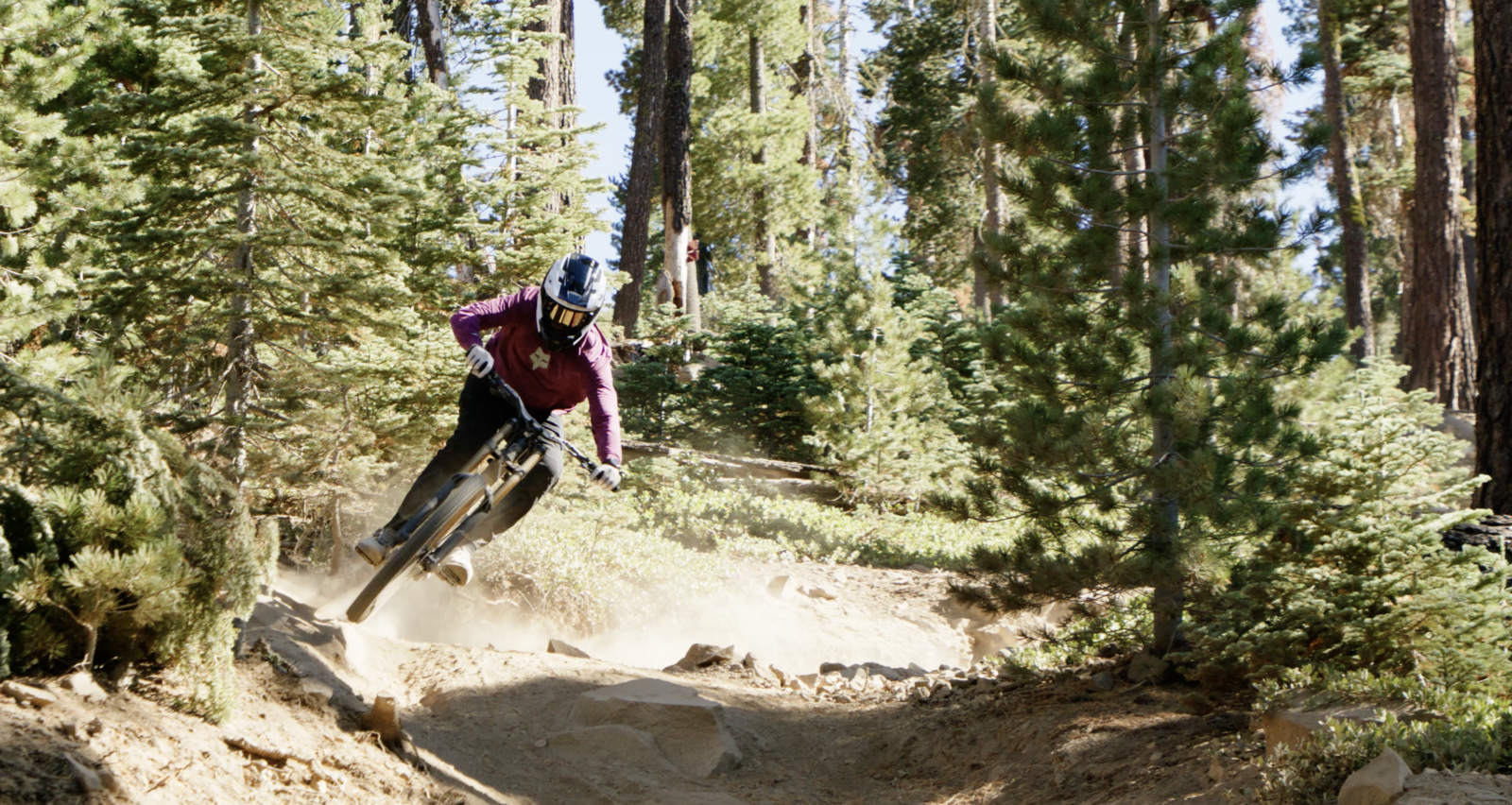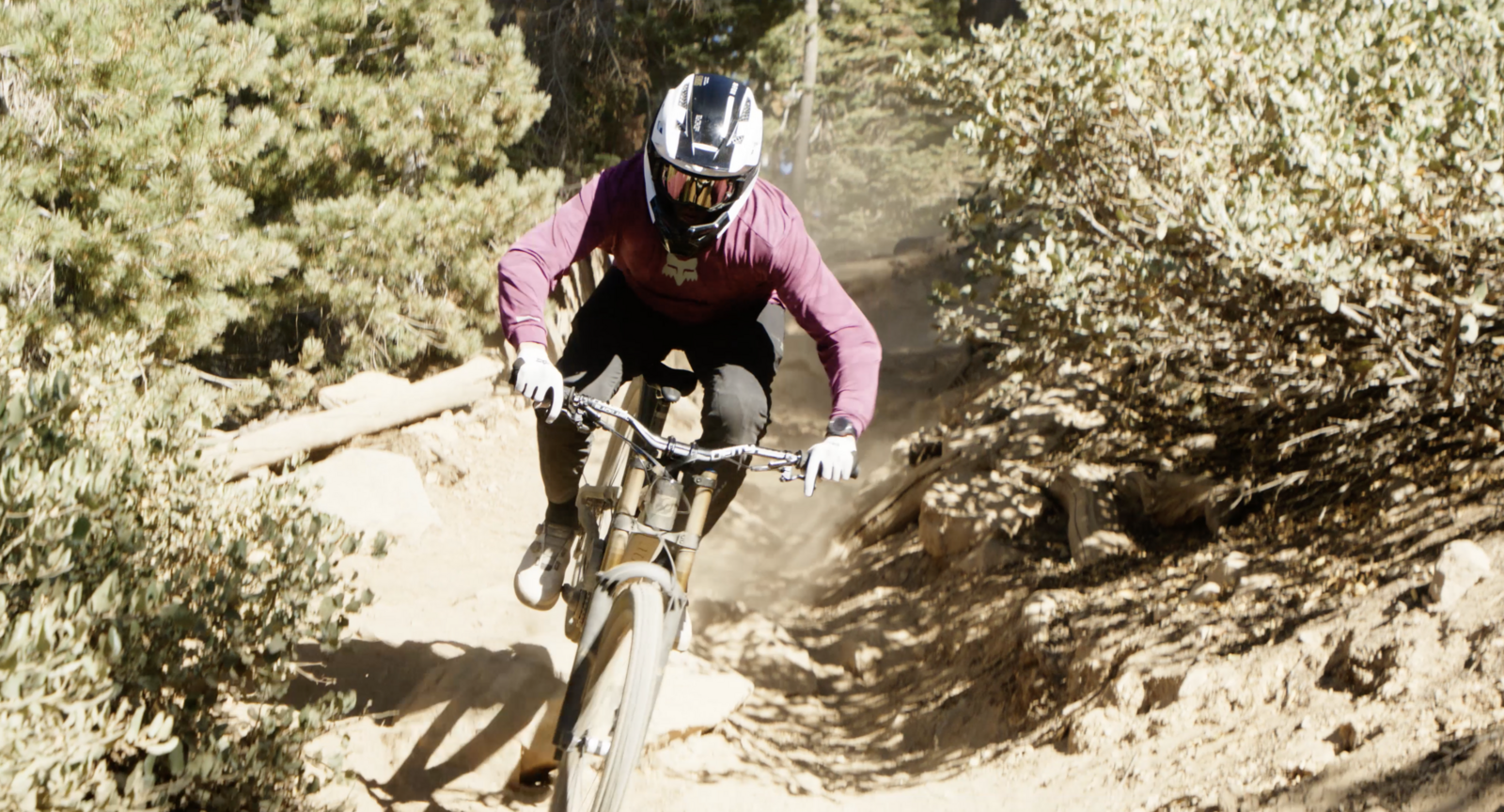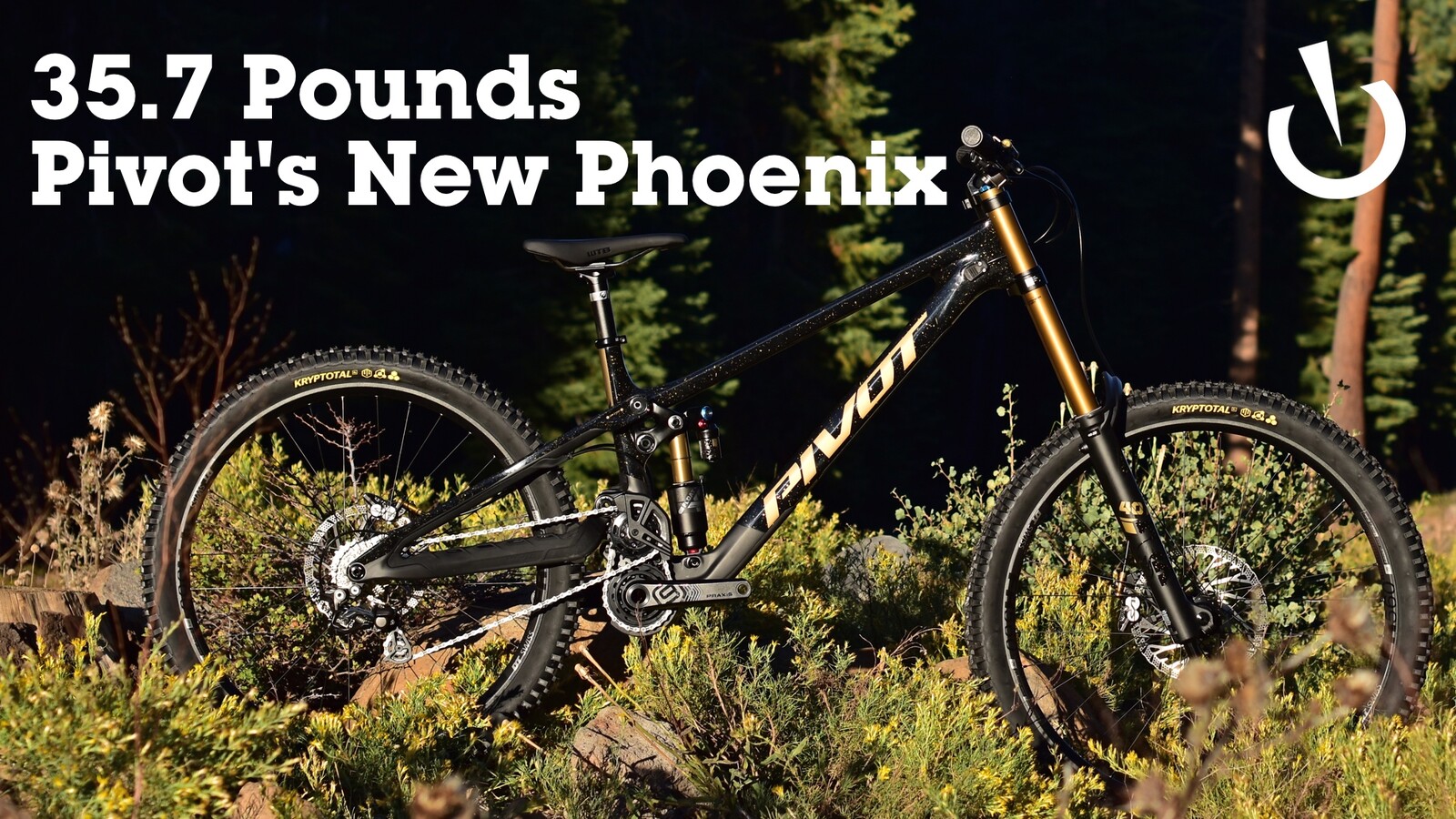The latest iteration of Pivot's downhill bike has been hard to ignore over the last two seasons for its unique drivetrain layout and the lugged carbon frame construction used during prototyping. The aluminum lugs are now gone, and a refined full-carbon Phoenix frame has emerged from the ashes with a sleek fit and finish. Taking input directly from the Pivot Factory Racing team, the new mixed-wheel bike's frame construction, geometry, and suspension platform focuses heavily on increased stability in the nastiest terrain.
Pivot Phoenix Highlights
- Full carbon frame
- 27.5 // 29-inch mixed wheel configuration (no 29-inch rear wheel compatibility)
- 210mm rear wheel travel // 203mm fork travel
- 62.3 (low) // 62.8-degree (high) headtube angle
- 440mm chainstay length across all sizes (25mm growth at 50% travel)
- DW6 suspension design
- Dual chain mid-drive chainring configuration
- Internal front triangle cable routing, external rear triangle routing
- Molded rubber frame protection
- Integrated fork bumpers
- Pressfit bottom bracket
- FOX and RockShox suspension options
- Shimano and SRAM drivetrain options
- Sizes: S1-S4 (Accommodates riders from: 5' 1" to 6' 7")
- Measured weight (size S4, no pedals): 35.7 lbs (16.19 kg)
- MSRP: $6,899 Ride GX DH // $8,499 Pro Saint (tested)
Overview
Last updated in 2019, Pivot took the race-driven ethos of the Phoenix as the primary focus with the next generation frame to improve performance, and they felt that the Phoenix 29 had room for improvement. For the fifth generation frame, Pivot has moved to a new DW6 suspension platform, grown dimensions across the bike, and built-in loads of adjustability to help the Phoenix stick to the ground more than before. The bike now rolls on mixed wheels only, and the change in suspension design increases rear wheel travel up to 210mm with 25mm of rearward movement; this rearward movement is where the eye-catching dual chain drivetrain layout comes into play. The frame now features a geometry flip chip and a kinematic flip chip to help riders cater the bike's dimensions and behavior to better suit specific types of terrain. A 1.5" diameter head tube allows for 5mm of reach adjustment in both directions via a reach-adjust headset, which Pivot offers, although any brand headset will work.
While the Phoenix frame started off with lugged tubes for more rapid prototyping, the tube profiles were anything but rushed into production. The lugs and tubes of the prototype frames were 100% manufactured by Pivot in-house, which allowed the engineers to create the exact flex profiles they were looking to create. Switching over to the full carbon frame has shed a bit of weight and allowed the engineers at Pivot to further dial in frame stiffness to the liking of their athletes. Regarding flex profiles, some may be wondering where the sixth bar of the DW6 platform fits into this equation, and the answer is in the seat stay itself. As if dual lower links weren't enough, the seat stay actually serves as a flex-stay rather than adding another pivot near the rear axle. Pivot did this to maintain a single-piece rear triangle construction rather than adding a pivot that would only rotate a mere degree or two through the rear wheel travel.
Mid-Drive
Being based in Phoenix, Arizona, Pivot has always prioritized pedaling efficiency and square edge bump performance, which is why their entire lineup is based around the DW Link. With the switch to a higher main pivot, the concerns around pedal kickback, chain drag, and chainring wear became higher priorities to ensure pedaling efficiency would suffer as little as possible. This drove Pivot and Dave Weagle to create an idler system that utilizes a dual-chain dual-idler layout they call a mid-drive layout. The engineers got a bit creative because there is no main pivot to center a standard idler around, and shifting the idler off of a main pivot dives into the territory of other patents. The solution was to mount the idler to the main triangle and move the main drive chain up to solve the issues of excessive chainstay wear and chain wrap to minimize drag and create a point where the chain can rotate around under growth. This double-sided upper idler allows the inner chain to tie the crankset to the rest of the drivetrain. This is where some thoughtful attention to detail was taken in the mounting interface of the upper idler. Mounted to the front triangle by a through axle, the mounting interface on the idler itself is concentric. It uses a 22mm cone wrench interface, making the inner chain easy to tension for mechanics and general consumers. Other fine details include a miniature chain guide around the upper ring and a rubberized ring around the lower chainring to silence any chain slap noise. The result is nearly zero pedal kickback and a virtually drag-free drivetrain performance while maintaining a supportive suspension platform.

Geometry
Pivot has moved away from the standard small through large sizing in favor of S sizing, allowing riders to choose which geometry fits them best. I opted for the largest size S4 frame for my test bike but could just as easily ride an S3 for a more nimble bike with dimensions more similar to the outgoing XL. My size S4 test bike shipped to me in the low setting, which provides a 515mm reach, 1333mm wheelbase, 635mm stack height, and 440mm chain stay length. While a 440mm chain stay is considered relatively short for the largest size bike compared to the reach and wheelbase measurements, the rear center grows 22mm throughout its travel with about 17mm gain around sag for an effective length of around 457mm out on the trail. When asked why they chose not to go size-specific on chainstay length, the engineers at Pivot mentioned they had tested with longer chainstays and that the team felt the bike felt a bit sluggish. In response, they stuck with the same size across the size run. The bike has a 106mm headtube across all sizes, which is quite short but allows for a wide range of adjustment for stack height and should suit riders of all sizes well. Speaking of adjustment, the geometry flip chip between the seat stay and upper rocker link allows for some quick changes in handling characteristics. Flipping into the high position takes the headtube angle from 62.5 to 62.93, extends reach by 5mm, and raises the bottom bracket height by 6mm for more responsive handling characteristics. As mentioned, a reach-adjust headset can be installed to further fine-tune dimensions by +/-5mm.

Build Kit Options
The Phoenix is offered in two different build kit options and features a full SRAM and RockShox option for the first time ever. The entry-level Ride GX DH kit retails for $6,899 and is highlighted by an SRAM GX DH 7-speed drivetrain, Maven Bronze brakes with 220/200mm HS2 rotors, a RockShox Boxxer Base level fork, and a Base level Vivid Air rear shock. The Pro Saint kit I received for testing retails for $8,499 and provides a top-of-the-line component spec, most similar to what the factory team runs. Suspension is handled by a FOX Factory 40 with a Grip X2 damper up front and a Float X2 rear shock. Stopping power comes from Shimano Saint brakes with Galfer shark 220/203mm rotors and a Saint drivetrain covers shifting. Both build kits use a set of DT Swiss wheels; the Ride GX DH kit gets a set of F1900 wheels, while the Pro Saint option comes with FR560 rims laced to 350 hubs, both wrapped in Continental Kryptotal DH casing tires in the super soft rubber compound. With the unique dual-chain system comes a unique set of chainrings manufactured by Praxis. Both build kits use a set of standard 165mm length DH-9 aluminum cranks and a 27t chainring with a 3-bolt direct mount interface. Pivot's in-house components round out the build kit with an adjustable 46-49mm direct-mount stem, 25mm rise carbon bar, waffle pattern grips, alloy seatpost, and co-branded WTB Hightail seat. A frame-only option is available for $4,799, which includes the Praxis chainrings, crankset, bottom bracket, and inner chain.
Pro Saint - $8,499
Ride GX DH - $6,899
Frame Kit - $4,799
On Trail
Initial Impressions
In person, the Phoenix looks fast standing still; the sharp design lines, low-slung tubes, and slim profile make the intentions clear that the bike means business. All pivot hardware is clearly labeled with torque specs, which are higher than most manufacturers' and should hold up well to the abuse that downhill bikes undergo from week to week. The cable routing is sleek, tucking the brake and shift housing behind the integrated fork bumpers, exits around the seat tube, and remains external along the rear triangle, allowing easy frame disassembly for service. The bike felt surprisingly light in hand, and putting the bike on a scale revealed the slim 35.7 lbs for my size S4 test bike. Overall, it's a well-put-together package with great attention to detail and looks to be a reliable option for anyone riding or racing on a regular basis.

Setup
I felt comfortable sitting on the bike right away with a slightly further forward weight bias than I would have preferred. To fix this, I swapped to a set of 38mm rise bars I usually run and a 50mm stem with 10mm of spacers below, which helped create a more upright posture and central weight bias. The bike was rather intuitive to ride right off the bat and carried a much lighter feeling on trail than I had anticipated. As I got into tighter, more technical terrain, the front wheel felt distant, as I would expect it to in instances where things go from steep to flat pretty regularly. While the bike did an excellent job of plowing through rocks and creating a ton of comfort when pushing closer to the limit through undulations of all shapes and sizes, I did struggle in sections where the overall speed and angle of the terrain were both lower than where the bike is most happy at.
| FOX Factory 40 Fork | FOX Factory Float X2 Shock |
|
|

Handling Characteristics
Switching the geometry flip chip into the high position helped the bike feel more predictable across flatter sections by shortening the rear center and tightening up handling slightly. Where slightly more fore and aft feedback in the roughest bits came with this change, the bike is so planted to begin with that it wasn't much of an issue, and the more even pressure at both wheels was a fair tradeoff that I found to be far more beneficial. The only drawback of running the bike in the high setting was that the bars felt a bit further away than I would have liked as the reach grew by 5mm. Of course, a reach-adjust headset would be the best solution for this, but I opted to roll the bars back slightly for the time being. Switching back to the low geometry setting helped solidify what it best suited: the steepest, gnarliest, high-speed terrain it can be thrown into. I found the low position allowed a much larger room for error when blitzing the faces of roots and square edges and found it to be notably more forgiving thanks to the slack 62.5° head tube angle and increase in front-center. I never felt my weight pitch forward while running into rocks and roots of all shapes and sizes, which was very rewarding when riding the bike with a high level of confidence.

Suspension Kinematics
On the topic of creating more even pressure at both wheels, experimenting with the kinematic flip chip revealed another subtle but significant change that improved my comfort on the bike. The more linear setting the bike ships in has around 24% progression from 30-90% of travel, whereas the more progressive setting provides around 28% progression through the travel; both positions support the use of air and coil shocks. What I found switching to the more progressive setting was a slightly higher starting leverage ratio, which created an even lighter feeling off the top, but the additional midstroke and bottom-out support is where I felt an increase in comfort. While it did cause more feedback to transmit through the bike when cruising, the firmer feeling helped keep more consistent pressure on the front wheel and matched my fork setup much better. I felt like I got a better return on everything I put into the bike in terms of rider input, which allowed me to pump the bike through undulations and compressions with a bit more comfort. This helped the bike feel a bit lighter, and it seemed to roll a bit faster through holes and heavier compressions by slowing input velocities transmitted through the bike more quickly.

Frame Construction
Downhill bikes are rad because they are the biggest and baddest iteration of a modern mountain bike that truly feel limitless when the terrain gets aggressive from their rock-solid foundation; the Phoenix provides that solid foundation without overdoing it. Grabbing the seat and rear wheel reveals a fair amount of lateral flex from head to toe, and this built-in flex came into play in a few instances through testing. The flex doesn't necessarily stand out but is happening in the background to add a bit of comfort through high-frequency chatter and providing a small buffer when leaning the bike hard into turns. This subtle flex aided traction across off-camber and offered a little forgiveness through blown-out turns with variable surfaces and helped keep the bike on a straight line. On the topic of frame construction unrelated to performance, the rigid tube profiles of the Phoenix make it resonate a good amount, and rock strikes off the downtube were certainly loud. The rubber downtube protection is pretty firm and has a slight gap on bigger frame sizes. I believe a softer durometer rubber for this application or an additional piece of rubber to fill in the gap would help silence the acoustic aspect of the frame.
Long Term Durability
The build kit is very well thought out and leaves little to be desired, posing no major durability concerns. The frame hardware components look relatively easy to service and use high torque specs throughout, which should hold up well in the long run. That being said, I encountered a few minor issues during testing, both cosmetic and functional, that likely wouldn't be continual. The cosmetic issues involved the rubber frame protection beginning to peel around the lower link where it attaches to the seat tube; luckily, this guard is wedged in a way where it can stay in place without adhesive. The rubber protection around the drive side of the rear triangle also peeled slightly as it sits on a rather narrow profile; this was a result of heel rub; I do ride my left foot forward, tend to tuck my heels in, a have large feet so this may not be an issue for everyone. As for functional issues I encountered, the inner drive chain de-tensioned a fair amount after a few laps. Inspecting the components after my first day of testing revealed the 3-bolt mounting interface of the idler needed to be re-torqued, which was an easy fix, and they remained tight for the remainder of the test. With a bit of slack in the system, I opted to re-tension the inner chain, which was much easier than anticipated and required a gentle amount of force to get right. After re-torquing and re-tensioning, I experienced no other issues with the frame hardware or components.

What's the Bottom Line?
Pivot set out to make a more race-focused bike that would stick to the ground in every part of a race track, and in my opinion, they have done exactly that. Compared to the outgoing model I spent a little over a year on, the highly active rear suspension and calm handling combine to make the gnarliest sections require less thinking to navigate. The bike's low weight and ground-hugging traits balance each other out, making it easy to tackle aggressive terrain and enjoyable when things are less hectic. My time on the bike reflected the race-inspired intentions of the bike, and my best experiences during that time were when I started pushing for quicker lap times. The build kits leave little to be desired and I think the quality of the frame and its components justify the price tag associated with it. The Phoenix may not be my first choice for riding tight and technical riding on a regular basis, but it is certainly high on my list of bikes that I would choose to race against the clock.
Please visit pivotcycles.com to learn more about the Phoenix.
View key specs, compare bikes, and rate the new Pivot Phoenix in the Vital MTB Product Guide.
About The Tester
Jonathon Simonetti - Age: 30 // Years Riding MTB: 21 // Height: 6’4” (1.93m) // Weight: 230-pounds (97.5kg)
Jonny started mountain biking in 2003 after a trip to Northstar showed him how much more could be ridden on 26” wheels than on a BMX bike. He began racing downhill in 2004 and raced for 12 years until ultimately deciding having fun on a bike was more important than race results. After working as a mechanic in the industry for a few years and developing a deeper understanding of bikes inside and out, he has an aptitude for pairing his riding ability with the analysis of bikes and breaking down what makes them work well. He spends most of his time between trail rides and skatepark sessions, with occasional days on the downhill bike.





















View replies to: 2025 Pivot Phoenix Downhill Bike Review
Comments